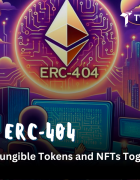One kind of cryptocurrency token stands in for physical assets that aren’t part of the digital realm; these are called Real World Assets (RWAs). Bonds, real estate, commodities, and machinery are all examples of what can be considered. By integrating them into the Decentralized Finance (DeFi) ecosystem, RWAs make these assets more accessible and open up new possibilities for use.

Making Sense of RWAs
The real assets that are represented by RWAs are assets that are both valuable and recognized by everyone. This means that their ownership and value are well-known and widely accepted, which makes them suitable for financial transactions and investments on a worldwide scale. They are monetary assets that people or businesses own with the expectation of future monetary gain. Selling or licensing the ownership can turn it into something valuable. A large chunk of the entire financial value in the world is comprised of these physical assets.
The revolutionary breakthrough is in the combination of these widely recognized physical assets with blockchain and DeFi through RWAs. Tokenization allows for the secure and easy purchase, sale, and trading of physical goods on digital platforms by transforming them into tokens on a blockchain. By combining physical assets with digital technologies, we can make things easier for everyone involved—from buyers to sellers—by increasing asset liquidity, accessibility, and transparency.
How Can RWAs Be Beneficial?
Any well-diversified investor’s portfolio should include conventional finance’s physical assets, since they make up a sizable chunk of the world’s total financial value. Those who have a lot of cryptocurrency in their portfolio may find that diversifying into these more traditional products strengthens their holdings. Regrettably, there are a number of obstacles that limit access to these conventional assets, such as high entrance barriers, geographical constraints, and liquidity problems.

Real estate and commodities are examples of traditional assets that typically demand a large initial investment. Bonds are another option, but a reasonable investment requires a considerable outlay as well, thus they are mostly available to the already wealthy. When it comes to asset accessibility, regulations, jurisdictions, and geographical locations are really important. The fact that asset ownership and investment restrictions vary from country to country makes it difficult, if not impossible, for foreign participants to invest without institutional support. People typically need to already have a specific amount of wealth for this, though.
The absence of rapid liquidity is a common characteristic of assets such as commodities and real estate. People who prefer shorter time frames or who need to get out of their holdings quickly may not be interested in these assets because of the time and effort required to convert them into cash.
These problems with conventional financial assets are innovatively addressed with crypto RWA tokens. Their capacity to reduce entrance barriers is one of the most revolutionary benefits they provide. Tokens representing fractions of real-world assets, such as bonds or real estate, can be bought by individuals thanks to their ability to facilitate fractional ownership. This method drastically lowers the starting capital needed, making these marketplaces accessible to a wider variety of people who may have been priced out before.

Beyond this, blockchain technology’s decentralization breaks down borders and rules. Assets that were previously bound by regional legislation or jurisdictional limits can now be freely transferred on this platform. This worldwide reach guarantees that individuals from all corners of the globe can access opportunities that may have previously been unavailable to them or too expensive for them to consider. In addition, bitcoin exchanges’ design makes assets that aren’t normally liquid more liquid. By quickly adapting to changing market conditions, people are able to enter or exit positions with ease.
Lastly, tokenization’s power lies in its capacity to break down physical assets into more manageable pieces. In addition to making investing more accessible to more people, this mechanism opens the door to a more diverse and inclusive asset ownership landscape. To put it simply, RWA tokens bring together the old and the modern, creating a fairer playing field in conventional financial markets.
Present Day Standout RWAs
A rapidly developing subset of the cryptocurrency market is RWAs. Among the many applications of RWAs are the following:
U.S. Treasury bills and bonds are examples of sovereign bonds that can be utilized to generate yield via bond RWA tokens. Investors can get a return on their money and take use of blockchain technology’s features like fractional ownership, improved transparency, and liquidity by tokenizing these bonds.
Real Estate: With tokenized real estate, investors can own a piece of a property and use it as a rental. More people will be able to afford to invest in real estate if this happens.

As a commodity, tokenized fine art enables individuals to possess a portion of a work of art and derive revenue from it. Investors in fine art may find this a useful alternative to buying a whole piece of art.
Art and Collectibles: Maecenas and similar platforms have revolutionized the ownership of artworks and collectibles by making it possible to purchase fractional ownership.
Industrial Equipment & Machinery: Tokenization is being considered by several companies as a means to optimize asset utilization by enabling fractional ownership and usage rights.
By uniting the old with the new, RWAs are revitalising the asset landscape. Their incorporation into the DeFi and blockchain spheres marks a significant step towards promoting diversity, creativity, and a wider range of investment choices. The use and scope of RWAs are predicted to skyrocket with the development of new technologies, altering people’s perspectives on investment and asset management in the process.










What do you think?